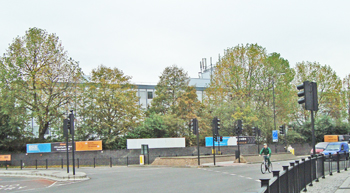Mental (private)
In 1758 William Clarke, a gentleman of Hackney, leased and converted Brooke House, a Tudor mansion built in 1532, into a private lunatic asylum. (In the second half of the 18th century there were numerous private madhouses in the northern and eastern suburbs of London.)
The asylum opened in 1759. It was managed by Clarke assisted by Miss Mary Hawkins, who also lived on the premises.
In 1762 Clarke obtained another lease for 50 acres of land from the Brooke House estate, to the west and south of the asylum.
When Clarke died in 1777, he left the asylum to his two brothers - John and the Revd Charles Clarke. His executors were Mary Hawkins and his brother John.
In 1781 the lease of Brooke House was bought by Dr John Monro (1715-1791) of Bedford Square, who had been a friend of William Clarke. Mary Hawkins continued to run the asylum.
Dr Monro, the son of Dr James Monro (1680-1752) and grandson of Alexander Monro, the principal of Edinburgh University, came from a long line of medical men who specialised in mental disorders. From 1728 to 1853 the family had supplied Bethlem Hospital with its principal physicians.
In 1774 the Madhouses Act was passed by Parliament requiring that private madhouses be licensed by a committee of the Royal College of Physicians. The first licence for Brooke House was granted to Dr John Monro. From 1784 it was granted to Mary Hawkins until her death in 1790. In her will she left some £11,000 (mostly in stock) and bequeathed £1,000 to Dr Monro and his wife and their three sons.
One of the sons, Thomas (1759-1833), who had qualified in medicine in 1787, assisted his father at Bethlem Hospital. He took over the licence for Brooke House in 1790, but his father kept financial control of the enterprise until his death in 1791. Dr John Monro left explicit instructions in his will that the three brothers should form a partnership to run the asylum (and also the one he owned in Clerkenwell Green, the Old Manor House, which had once belonged to Dr William Battie (1703-1776) of St Luke's Hospital; this was relinquished by Thomas in 1803. It is now the site of the Northampton Institute, part of the City University). As the physician in charge of the asylum, Thomas received the largest share of the profits.
The patients in the asylum came from the middle and upper classes. Their treatment did not differ much from patients held at Bethlem, except that they were not restrained by chains, on the grounds that the use of chains was "fit only for pauper lunatics; if a gentleman was put in irons, he would not like it". In Brooke House violent patients were kept in separate rooms, and for the 40 or so patients there were an equal number of attendants.
In 1818 Dr Thomas Monro retired and was succeeded by his son, Dr Edward Thomas Monro (1790-1856), who was granted the licence for Brooke House.
In 1820 Dr Thomas Monro and his uncle, Charles Monro, the son of Dr John Monro, purchased the freehold of Brooke House from the Earl of Warwick, together with the 50 acres of land originally leased by William Clarke.
In 1846 the license for the asylum was granted to the Misses Pettingall, who had presumably become the resident superintendents. In 1847 Dr Edward Thomas Monro's son, Dr Henry Monro (1817-1891), became the licensee.
In 1868 Dr Henry Monro formed a partnership with Dr Josiah O. Adams to manage Brooke House. Dr Adams continued to run the asylum after the death of Henry Monro in 1891.
The Monro family continued to own the property, leasing the asylum to a resident superintendent.
Since the mid 19th century the area around Brooke House was increasingly developed, with new roads - Rendlesham, Downs, Nightingale and Walsingham - being laid down and then lined with detached and semi-detached family houses. In 1909 part of the forecourt of the asylum was appropriated for the widening of Upper Clapton Road. A projecting building was demolished and a smaller one erected on part of its site.
During WW2 the patients were evacuated and the asylum closed. In October 1940 the north courtyard and its surrounding buildings were destroyed by a high explosive bomb. The south courtyard and its buildings suffered blast damage.
The asylum did not reopen after the war.
Present status (November 2009)
In 1944 the LCC purchased the house and 5.5 acres of the Brooke House estate. Further bomb damage occurred that same year.
Brooke House was demolished in 1954 and a new school - Brooke House School - was built on the site in 1960.
Today the site contains the BSix Sixth Form College, which opened in September 2002.

The BSix Sixth Form College has few windows.

The main bulk of the building is hidden behind a line of trees along Upper Clapton Road.
http://studymore.org.uk
http://wapedia.mobi
www.british-history.ac.uk
www.hackney.gov.uk
Return to home page